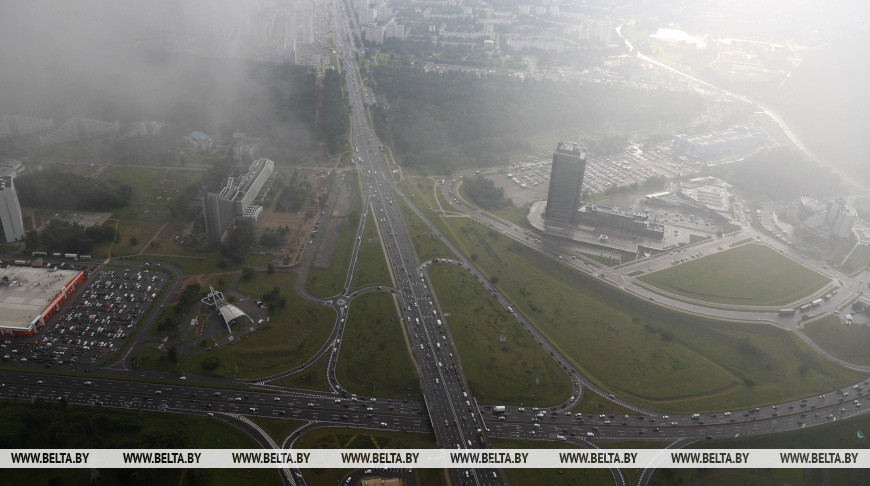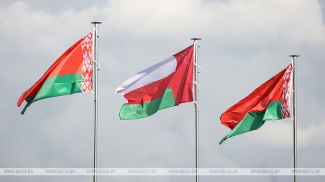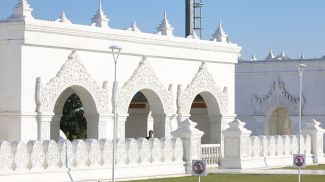
MOZYR 6 November (BelTA) – During a working trip to Mozyr District Belarus President Aleksandr Lukashenko took part in a solemn ceremony to open a renovated bridge over the Pripyat River in the city of Mozyr, Gomel Oblast on 6 November. The president was also informed about plans to build roads in Belarus in the next few years, BelTA has learned.
Transport and Communications Minister Aleksei Lyakhnovich said: “We will go ahead with reconstruction site by site. Those are mainly in international transport corridors.”
In particular, the motorways M3, M10, P46, P99, and P122 were mentioned as well as the sections of the P28, P53, and P83 motorways that handle heavy traffic.
Aleksei Lyakhnovich informed Aleksandr Lukashenko about plans to reconstruct roads in the direction of Vitebsk and Polotsk. At present all the oblast capitals are connected to the city of Minsk with first-category motorways, except for Vitebsk. The section from Minsk to Lepel of the M3 Minsk-Vitebsk motorway and the P46 motorway make up a transport corridor in the direction of port infrastructure in Leningrad Oblast, Russian Federation.
In order to make the transportation of exports and imports more efficient, the section of the M3 Minsk-Vitebsk motorway from Pleshchenitsy to the borders of Minsk Oblast and Vitebsk Oblast is being upgraded to the first technical category. The reconstruction of the P46 motorway from Lepel to Polotsk continues. It is supposed to be finished in 2026. In turn, the major overhaul of the P46 motorway from Polotsk to the border of the Russian Federation was completed in 2024.
“The center of Vitebsk Oblast will be linked to Minsk in this manner. People should be grateful that we are doing it,” the head of state made a conclusion.
Reconstruction is also in progress in another international corridor: the P122 Mogilev-Chausy motorway. “We have started working on a section of the road and we will finish it during the next five-year term,” Aleksei Lyakhnovich said. “A section about 40km long.”

“If we decide to build a nuclear power plant over there in the east, you will have to do it faster,” Aleksandr Lukashenko noted in response.
The reconstruction of the M10 motorway has begun. The road begins at the Russian border and leads to the city of Kobrin. “When will we have the road to Kobrin ready?” the head of state wondered.
“We see that the section from Gomel to Mozyr we’ve just started handles heavy traffic,” the minister reported.
The reconstruction of a 86km-long section of the M10 motorway from Rechitsa to Kalinkovichi is in progress and is supposed to upgrade the road to the first technical category. The road will feature a concrete surface course.
Aleksandr Lukashenko stressed that without a doubt this section of the motorway needs work, it is needed for domestic purposes. However, he was not satisfied with the plans to finish this section only by 2029 and he suggested working faster. “The road [from Gomel] till Mozyr should be as good as the road from Minsk to Gomel. And it should be done faster,” he said. “And work from Mozyr further on via Petrikov, Zhitkovichi, and till Kobrin should be paused for now. Something may change though.”
According to Transport and Communications Ministry representatives, the intensity of traffic in the Kalinkovichi-Kobrin 343km-long section of the M10 motorway corresponds to the current category of the road. Plans are in place to keep this section in good repair.
Some of the minister’s report focused on the president’s instruction to try laying down concrete road foundation on top of asphalt. This approach has been tested in a small section of the M4 Minsk-Mogilev motorway with good results.
“In other words, it is acceptable? Can we lay concrete on top of asphalt?” the head of state asked for clarification.
The head of state was informed that the approach requires less work and offers lower costs in comparison to reconstruction.
“If it is justified and technologically correct, it should be done,” the president said.
A decision was made in favor of using a similar technology to build the main exits out of Minsk in order to avoid having to introduce summer restrictions and spring restrictions for heavy trucks later on. The concrete surface course will greatly improve the quality of the upper layer of the motorway sections that see the heaviest traffic and will increase the axle weight limit to 11.5 tonnes.
Aleksandr Lukashenko also received a separate report in response to his instructions to build solid-surface roads to agrotowns. “We have roads that connect oblast capitals with district capitals. We don’t have a single district capital that is not connected to an oblast capital with a solid-surface road. It is necessary to move on from district capitals to agrotowns,” the head of state said.
The government had previously approved a list of 34 agrotowns, roads to which have to be improved in a total distance of 156km in 2025-2026. As much as 108km of the roads has been built to 29 agrotowns (most of them are located in Vitebsk Oblast). Five population centers and 48km of the roads will be taken care of in 2026.
Aleksandr Lukashenko remarked it is necessary to very attentively approach this work and focus on promising agrotowns. “If you decide that there will be an agrotown over there, then you should repair the road that leads to it or build one,” the head of state said. “The agrotown doesn’t matter [as the formal status of a population center]. People do. If people live there, you have to build the road. But if we understand that people don’t live there, why then would you build such a road? This is why it is necessary to once again reexamine the country as a whole and Vitebsk Oblast. And we will find ways to spend money.”
The head of state urged officials to act in the same manner with regard to smaller villages. “We need to see the dynamics. The perspective. If there are 200 people and people leave every year and this village will be gone, why would you put efforts into it? We are statesmen, after all. We need to do things where they are necessary. Organize an audit and make sure we don’t waste money in unnecessary locations,” he said.
On the whole, thanks to the realization of the government program in 2021-2025 as much as 18,000km of major and minor motorways will be repaired and reconstructed in addition to 24,000 running meters of bridge structures (477 pieces).
One of the five priorities stipulated by the concept of the program on Belarus’ social and economic development for the next five-year term is “Quality roads – new roads in compliance with modern quality standards”. One of the main tasks to secure this priority is repairs and reconstruction of 25,000km of public automobile roads.
The Transport and Communications Ministry and interested parties have drafted a government program Belarus Roads for 2026-2030.













